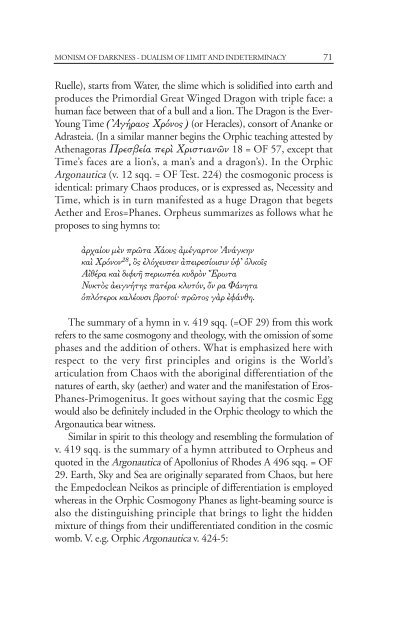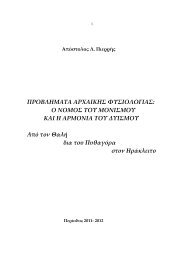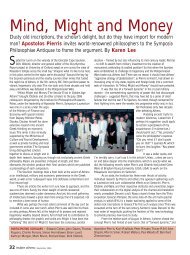chapter 10 the monism of darkness and the dualism of limit and ...
chapter 10 the monism of darkness and the dualism of limit and ...
chapter 10 the monism of darkness and the dualism of limit and ...
You also want an ePaper? Increase the reach of your titles
YUMPU automatically turns print PDFs into web optimized ePapers that Google loves.
MONISM OF DARKNESS - DUALISM OF LIMIT AND INDETERMINACY 71<br />
Ruelle), starts from Water, <strong>the</strong> slime which is solidified into earth <strong>and</strong><br />
produces <strong>the</strong> Primordial Great Winged Dragon with triple face: a<br />
human face between that <strong>of</strong> a bull <strong>and</strong> a lion. The Dragon is <strong>the</strong> Ever-<br />
Young Time (\AÁ‹Ú·Ô˜ XÚfiÓÔ˜) (or Heracles), consort <strong>of</strong> Ananke or<br />
Adrasteia. (In a similar manner begins <strong>the</strong> Orphic teaching attested by<br />
A<strong>the</strong>nagoras ÚÂۂ›· appleÂÚd XÚÈÛÙÈ·ÓáÓ 18 = OF 57, except that<br />
Time’s faces are a lion’s, a man’s <strong>and</strong> a dragon’s). In <strong>the</strong> Orphic<br />
Argonautica (v. 12 sqq. = OF Test. 224) <strong>the</strong> cosmogonic process is<br />
identical: primary Chaos produces, or is expressed as, Necessity <strong>and</strong><br />
Time, which is in turn manifested as a huge Dragon that begets<br />
Ae<strong>the</strong>r <strong>and</strong> Eros=Phanes. Orpheus summarizes as follows what he<br />
proposes to sing hymns to:<br />
àÚ¯·›Ô˘ ÌbÓ appleÚáÙ· X¿Ô˘˜ à̤Á·ÚÙÔÓ \AÓ¿ÁÎËÓ<br />
ηd XÚfiÓÔÓ 28 , n˜ âÏfi¯Â˘ÛÂÓ àappleÂÈÚÂÛ›ÔÈÛÈÓ ñÊ’ ïÏÎÔÖ˜<br />
Aåı¤Ú· ηd ‰ÈÊ˘É appleÂÚȈapple¤· ΢‰ÚeÓ òEÚˆÙ·<br />
N˘ÎÙe˜ àÂÈÁÓ‹Ù˘ apple·Ù¤Ú· ÎÏ˘ÙfiÓ, ¬Ó Ú· º¿ÓËÙ·<br />
ïappleÏfiÙÂÚÔÈ Î·Ï¤Ô˘ÛÈ ‚ÚÔÙÔ›Ø appleÚáÙÔ˜ ÁaÚ âÊ¿ÓıË.<br />
The summary <strong>of</strong> a hymn in v. 419 sqq. (=OF 29) from this work<br />
refers to <strong>the</strong> same cosmogony <strong>and</strong> <strong>the</strong>ology, with <strong>the</strong> omission <strong>of</strong> some<br />
phases <strong>and</strong> <strong>the</strong> addition <strong>of</strong> o<strong>the</strong>rs. What is emphasized here with<br />
respect to <strong>the</strong> very first principles <strong>and</strong> origins is <strong>the</strong> World’s<br />
articulation from Chaos with <strong>the</strong> aboriginal differentiation <strong>of</strong> <strong>the</strong><br />
natures <strong>of</strong> earth, sky (ae<strong>the</strong>r) <strong>and</strong> water <strong>and</strong> <strong>the</strong> manifestation <strong>of</strong> Eros-<br />
Phanes-Primogenitus. It goes without saying that <strong>the</strong> cosmic Egg<br />
would also be definitely included in <strong>the</strong> Orphic <strong>the</strong>ology to which <strong>the</strong><br />
Argonautica bear witness.<br />
Similar in spirit to this <strong>the</strong>ology <strong>and</strong> resembling <strong>the</strong> formulation <strong>of</strong><br />
v. 419 sqq. is <strong>the</strong> summary <strong>of</strong> a hymn attributed to Orpheus <strong>and</strong><br />
quoted in <strong>the</strong> Argonautica <strong>of</strong> Apollonius <strong>of</strong> Rhodes A 496 sqq. = OF<br />
29. Earth, Sky <strong>and</strong> Sea are originally separated from Chaos, but here<br />
<strong>the</strong> Empedoclean Neikos as principle <strong>of</strong> differentiation is employed<br />
whereas in <strong>the</strong> Orphic Cosmogony Phanes as light-beaming source is<br />
also <strong>the</strong> distinguishing principle that brings to light <strong>the</strong> hidden<br />
mixture <strong>of</strong> things from <strong>the</strong>ir undifferentiated condition in <strong>the</strong> cosmic<br />
womb. V. e.g. Orphic Argonautica v. 424-5:










